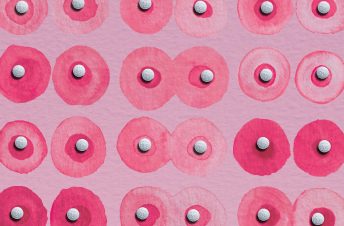Can Women With Fake Breast Breast Feed
Most women who have breast implants can still breastfeed, but there are things you should know about feeding post-surgery.
If you've had a breast augmentation surgery, you may be wondering if it will affect your ability to breastfeed your baby. The good news is that most women can still breastfeed just fine, as the surgery usually doesn't involve the ducts or the areas of your breast involved in milk production. And the silicone in today's breast implants is unlikely to leach into the milk.
But the risk of an augmentation affecting breastfeeding depends on where the incision is made in the breast and what kind of surgery you had. In a typical breast augmentation surgery, a cut is made in what's called the inframammary fold, which is the crease under your breast, and an implant is placed behind the pectoral muscle, which lies below the breast tissue. In this scenario, "The implantation is actually away from the breast, so all of the ducts that were there to begin with are still intact, and still connected to the nipple," explains John Semple, head of plastic surgery at Women's College Hospital in Toronto.
Although this is the most common method of breast augmentation, there are times the incision is done in the armpit or around the areola, usually for cosmetic reasons (to make the scar less visible). An incision around the areola may affect sensation of the nipple and interfere with the signals needed for the letdown reflex, which can affectmilk supply. Some ducts may be severed as well, but you won't know the full extent of this until you try to breastfeed. And in some surgeries, the implant is placed over the pectoral muscle, which, in rare cases, may interfere with the ducts. If you are unsure of what type of procedure you had, contact your plastic surgeon for details.
 Is domperidone really a magic breastfeeding pill? The other thing to consider is the reason you had the augmentation surgery in the first place. If you had fairly symmetrical, regularly shaped breasts and you just wanted a little boost, then chances are you will not run into difficulty breastfeeding, explains Taya Griffin, a lactation consultant in Toronto. But, if you had very flat or tubular shaped breasts before your augmentation, you may have been at risk for low milk supply regardless of having surgery. She adds that some breasts don't develop properly during puberty and therefore don't contain enough glandular tissue to produce the necessary breastmilk.
Is domperidone really a magic breastfeeding pill? The other thing to consider is the reason you had the augmentation surgery in the first place. If you had fairly symmetrical, regularly shaped breasts and you just wanted a little boost, then chances are you will not run into difficulty breastfeeding, explains Taya Griffin, a lactation consultant in Toronto. But, if you had very flat or tubular shaped breasts before your augmentation, you may have been at risk for low milk supply regardless of having surgery. She adds that some breasts don't develop properly during puberty and therefore don't contain enough glandular tissue to produce the necessary breastmilk.
If you've had an augmentation and you want to breastfeed, Griffin suggests doing everything possible to get things off to a good start, especially if you suspect you may have had insufficient glandular tissue. (One sign of this is if your breasts didn't change during pregnancy.)
She recommends taking natural supplements that are thought to promote milk production, such as fenugreek and blessed thistle, and potentially talking to your doctor about getting a prescription for domperidone, the drug that enhances milk production, to have on hand in case you do have a low supply.
Make sure your baby is latching well, and if you have concerns, you may want to reach out to a lactation consultant or a breastfeeding clinic. "We really want to maximize the supply that you do have," says Griffin.
Semple notes that women who've undergone augmentation also need to be extra careful about breast infection, known as mastitis, because it can increase your risk for capsular contracture, which occurs when scar tissue tightens around the implant. This can be quite painful and, in severe cases, can lead to your implants being removed.
Make sure you tell your healthcare provider you've had the surgery, so they can monitor your baby's weight gain and ensure feeding is going smoothly. If you do have low milk supply, you may need to supplement with formula. Pumping can sometimes help, but Griffin notes that it's a very individual choice—pumping in addition to breastfeeding can be exhausting, so she doesn't always recommend it. Instead, she encourages women to use a lactation aid, also called a supplemental nursing system, where the supplemental milk is in a container attached to a tube which is placed into the baby's mouth while he's sucking at the breast. The additional removal of milk from the breast signals your body to produce milk, explains Griffin. "This helps maximize the breast milk supply, but also means baby can exclusively feed at the breast, if that's what mom desires."
Read more:
10 of the cruelest things anyone can say to a mom struggling to breastfeed
Can you breastfeed after breast reduction surgery?
Source: https://www.todaysparent.com/baby/breastfeeding/can-you-breastfeed-with-implants/
0 Response to "Can Women With Fake Breast Breast Feed"
Post a Comment